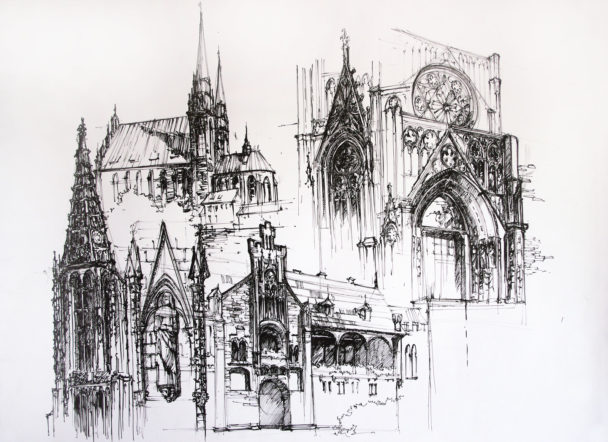
In my last blog, I addressed a few of the common pushbacks against building from a Christian perspective. What I said can be true for most buildings, but we have a very unique one. I want to help you to understand the specific language of the building we worship in every week. The building that we gather in was designed in a language that is oriented toward God; that language is part of the act of worship. In an article for the Institute of Sacred Architecture, Ethan Anthony describes the impact of the building on the liturgical experience:
Architecture has the capability to define through formal language that we come to identify the activities that occur within by the form of the architecture. The activities and the forms become interdependent. To the extent that the architecture incorporates these forms and linguistic elements we feel at home and comfortable. Conversely, to the extent that these elements are missing we may feel less at home, less comfortable. Our sense of well-being is affected by the architecture. The result of a sense of negative affect—or lack of well-being—may be a tendency not to return to the space, i.e. a loss of interest.
We understand the activities that happen because of the architecture (we recognize a church because of the steeple and cross) and the activities themselves are fed by the elements of design. What are the elements of our building and how do they accentuate our worship?
The building that we meet in was designed in the Neo-Gothic (or Gothic revival) style. The original Gothic period had a long life from 1100s to the 1600s. It’s resurgence in the mid 1900s was aided by the writings of two men: A.W.N. Pugin and John Ruskin. Both argued that Gothic architecture was the superior style, going so far as to call it ‘Christian architecture.’ In the Neo-gothic period, many churches were designed in the gothic form, but with a scaled back ornamentation (possibly because the kind of detail that the original Gothic style contained far surpassed most church budgets). There are a few things that were kept that express the ‘Christian’ aesthetic:
The Gothic Arch
One of the most recognizable details in a gothic building is the pointed arch. Standing in contrast to the roman arch (which was developed in a pantheistic culture), the gothic arch came to a point. It’s sharp point faced upward, toward the heavens. The point then, is a sign (literally pointing) that focuses the viewer upward to a single source of all things.
Stained Glass Windows
While many of the early reasons for stained glass windows were for catechesis (sort of a glass felt board), in the post-reformation world, the meaning became about the light. The light from stained glass splashes color throughout the sanctuary, creating a unique visual experience that can be best explained as ‘divine.’ What does colored light have to do with God? Nothing, and yet, almost every person senses a heightened experience connected with walking into a space in which none of the light enters untouched. An author on classical architecture encouraged churches to return to this simple communicative device, stating:
The modern church would do well to rediscover these proven catechetical techniques, filling church interiors with beautiful images of colored light, thereby satisfying human desires for visual stimulation, symbolic representations of theological truths, and the touch of the mystical in prayer. Modern eyes are exposed to so much sophisticated visual imagery; our catechetical efforts should include much more than written words by building upon the rich heritage of visual catechesis displayed by the traditions associated with stained glass windows.
Many wouldn’t consider it, because you lose control of the light when you allow it to stream in unfiltered (as the slides sometimes reflect) and yet, what better way to communicate what we get in relationship with God: far more beautiful, a bit unpredictable.
Acoustic congregation space
The loud room affect in our church makes controlling the projected sound difficult. This is because the space was not designed for guitar and drums, it was designed for organ. Along with the organ, it was designed for congregational singing. The way that the acoustics work is that as you offer your worship to God, it joins with all of the other voices and comes back as a single, unified voice. This was shocking for us as a church, coming from a space that was designed to cut out reverb. It reflects the act of us all coming to join with the family to offer up our praise to God (in one voice), and then receiving the blessings of community as a gift from Him.
All of this is not to try to create a ‘how our space is better than other spaces,’ but instead to understand the space that God has given to us and to allow it to become part of how we experience Him in our Sunday gathering.